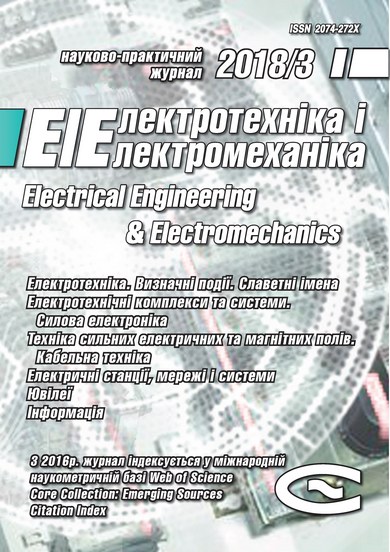SYNTHESIS OF A TWO-MASS ELECTRIC DRIVE WITH AN ASTATIC SYSTEM OF SUBORDINATE REGULATION AT THE ACTION OF VARIABLE FRICTION FORCES
DOI:
https://doi.org/10.20998/2074-272X.2018.3.03Keywords:
electromechanical system, damping, electric drive, interaction, regulation, speed controller, synthesis, variable friction forcesAbstract
Purpose. The solution of actual problem of active suppression of resilient electromechanical vibrations in an electric drive with the astatic system of automatic control is presented. Methodology. For research of damping properties of electrical drive according to a flow diagram from transmission functions on regulation and indignation a characteristic polynomial is got in the rationed form of parameters that takes into account the physical phenomena and sets intercommunications of parameters in the electromechanical system. As a result of it a characteristic polynomial at a successive dynamic decoupling appears separate interactive electromagnetic and mechanical subsystems. Thus, electromechanical interaction physically means complete extraction of energy of vibrations from a mechanical subsystem in electromagnetic with simultaneous transformation for minimum time. An electric drive for the case of realization of processes of electromechanical interaction is the dynamic extinguisher of vibrations. Results. The active resilient mechanical oscillation damping comes true due to optimization of dynamic inflexibility of mechanical description of electrical drive and as a result the required degree of stability is provided at minimum vibration and high exactness of working off indignations on loading. Originality. For the first time an electrical drive with the astatic system of automatic control at the action of variable forces of friction for the offered optimal parameters of dynamic inflexibility of mechanical description effectively damps vibrations. The synthesis of parameters of regulators according to correlations allowed to realize the maximum indexes of character of attenuation processes at a zero static error. Practical value. The synthesis method is approved in industrial conditions during the adjustment and modernization of the machine tool and is recommended for setting up automatic control systems for the operating and newly designed electric drives of technological machines.References
1. Kliuchev V.I. Teoriia elektroprivoda [Theory of the electric drive]. Moscow, Energoatomizdat Publ., 2001. 704 p. (Rus).
2. Popovich M.G., Lozins'kii O.Iu., Klepіkov V.B. Elektromekhanіchnі sistemi avtomatichnogo keruvannia ta elektroprivodi : navch.posіbnik dlia stud. vishch. navch. zakladіv, iakі navchaiut'sia za napriamom «Elektromekhanіka» [Electromechanical systems of automatic control and electric drives: a manual for students of higher educational institutions in the direction of «Electromechanics»]. Kyiv, Lybid Publ., 2005. 680 p. (Ukr).
3. Andriushchenko V.A. On the stability of the traction electric drive of low speeds with unlimited increase of some of its parameters. Russian Electromechanics, 1976, no.1, pp. 100-103. (Rus).
4. Ivanchenko F.K. Mekhanika privodov tekhnologicheskikh mashin [Mechanics of drives of technological machines]. Kyiv, Vishcha shk. Publ., 1986. 152 p. (Rus).
5. Besekerskii V.A. Dinamicheskii sintez sistem avtomaticheskogo regulirovaniia [Dynamic synthesis of automatic control systems]. Moscow, Nauka Publ., 1970. 576 p. (Rus).
6. Klepikov V.B., Osichev V.B. Determination of the stability limits of an electric drive with negative viscous friction taking into account the elasticity of the kinematic chain. Electricity, 1989, no.1, pp. 36-41. (Rus).
7. Bortsov Iu.A., Sokolovskii G.G. Avtomatizirovannyi elektroprivod s uprugimi sviaziami [Automated electric drive with elastic connections]. St. Petersburg, Energoatomizdat Publ., 1992. 288 p. (Rus).
8. Burgin B.Sh. Analiz i sintez dvukhmassovykh elektromekhanicheskikh sistem [Analysis and synthesis of two-mass electromechanical systems]. Novosibirsk, NETI Publ., 1992. 199 p. (Rus).
9. Samuelsson O. Load modulation at two locations for damping of electromechanical oscillations in a multimachine system. Power Engineering Society Summer Meeting 2000. IEEE, 2000, vol.3, pp. 1912-1917. doi: 10.1109/pess.2000.868826.
10. Zadorozhnii N.A., Marilov N.G., Kutovoi Iu.N., Arus Mokhammed. Analysis of electromechanical drive systems with elastic mechanical connections in the regime of low speeds and slippin. Bulletin of NTU «KhPI». Series: Problems of automated electric drive. Theory and practice. Kharkov, 1997, pp. 122-123. (Rus).
11. Zadorozhnii N.A., Zadorozhniaia I.N. Synthesis of parameters of an astatic automatic control system for two-mass electric drives with a specified degree of stability and minimum oscillation. Bulletin of NTU «KhPI». Series: Problems of automated electric drive. Theory and practice, 2015, no.12(1121), pp. 155-159. (Rus).
12. Zadorozhnia І.M. Optimization of dynamic modes of drives of metallurgical machines with minimization of influence of elastic oscillations. Electromechanical and Energy Systems, Modeling and Optimization Methods. Conference proceedings of the 11th International conference of students and young researches. Kremenchuk, April 9-11, 2013, pp. 51-52. (Ukr).
13. Zadorozhnii N. A., Rebedak O. A., Zadorozhniaia I.N. Features of the work of the feed mechanism deep machine KZH-1910 in low speed mode. Bulletin of NTU «KhPI», 2013, no.36(1009), pp. 209-210. (Rus).
Downloads
Published
How to Cite
Issue
Section
License
Copyright (c) 2018 I. N. Zadorozhniaia, N. A. Zadorozhniy

This work is licensed under a Creative Commons Attribution-NonCommercial 4.0 International License.
Authors who publish with this journal agree to the following terms:
1. Authors retain copyright and grant the journal right of first publication with the work simultaneously licensed under a Creative Commons Attribution License that allows others to share the work with an acknowledgement of the work's authorship and initial publication in this journal.
2. Authors are able to enter into separate, additional contractual arrangements for the non-exclusive distribution of the journal's published version of the work (e.g., post it to an institutional repository or publish it in a book), with an acknowledgement of its initial publication in this journal.
3. Authors are permitted and encouraged to post their work online (e.g., in institutional repositories or on their website) prior to and during the submission process, as it can lead to productive exchanges, as well as earlier and greater citation of published work.





